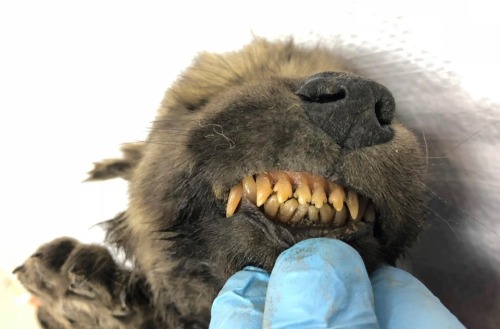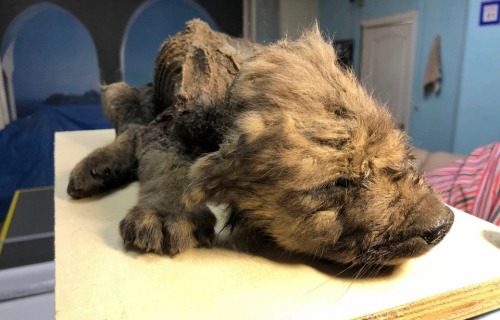Invasive Species And The Burmese Python
Invasive Species and the Burmese Python
Have you ever heard the term, “invasive species”? Listen along to this month’s podcast from the Sawgrass Nature Center as our staff teams up with the Nature Conservancy of Southwest Florida to discuss invasive species and the Burmese Python problem in the Everglades!
https://anchor.fm/snc-wild/episodes/Invasive-Species-and-the-Burmese-Python-Part--I-e11n04k
More Posts from Sawgrassnaturecenter and Others


Dogor is the 18,000 year old pup that was found within the Siberian Permafrost, yet is not quite a dog nor a wolf, but a puzzling connection to both.
Dogor has been miraculously preserved within the permafrost, with its fur, teeth and even whiskers incredibly intact. Radiocarbon dating has placed the animal at 18,000 years old and researchers have suggested that the animal passed away at just 2 months old. The name Dogor means “Friend” in Yakut, a language spoken within Eastern Siberia.
Generally, genetic analysis can quite easily discern whether a discovered canine is a wolf or dog, but in this instance, the genetics suggest that it could be an ancestral link to both. Interestingly, Dogor lived at a time in canine evolutionary history when dogs and wolves began to branch off from each other.The general scientific consensus is that dogs and wolves split from a common ancestor, however, the process of how “dogs became dogs” is certainly contested, and Dogor could be a crucial piece in that puzzle.
If Dogor is determined to be a dog, it will be the oldest ever discovered. The next oldest, the Bonn-Oberkassel puppy, was discovered in Germany and was clearly determined to be a dog of around 14,000 years old, buried with a man and a woman.
The progression of climate change is melting the permafrost more rapidly, and discoveries like these are becoming more and more commonplace.
Images via Sergey Fedorov/The Siberian Times


In honor of National Wildlife Day, we took out our native Florida gator for an educational program. Florida gators are considered a keystone species. That means they’re responsible for establishing an ecosystem/habitat for several other species of animals to inhabit as well. Without gators, Florida’s animal ecology would be in serious trouble.
Note: licensed and trained professionals are responsible for handling all wild animals. Please do not try this at home.
Great Horned Owls are native to the Americas, with a preference for deciduous, coniferous, forest, and desert habitats. They are carnivores with a diet that includes small mammals, reptiles, and even other owls!
Fun fact: When clenched, a Great Horned Owl’s strong talons require a force of 28 pounds to open.
Our resident owl is with us due to a permanent wing injury that prohibits them from ever flying properly again.

Sinbad
A fan favorite at the Sawgrass Nature Center and Wildlife Hospital, is Sinbad, a yellow-naped amazon parrot. The main mission of the SNC is to rehabilitate and release native wildlife back into the wild, but sometimes we have to provide permanent residency to the animals that come our way. Sinbad is a great example of two of the usual three reasons.
Previous Pet
In the wild, yellow-naped amazon parrots can live twenty to thirty years. In captivity, however, they can live sixty – eighty years. That means any potential pet owner of this gorgeous bird would have to plan for what is going to happen to their beloved parrot upon their death. Sinbad out lived two owners. The extended family of his owners reached out to the Sawgrass Nature Center for help and Sinbad became a permanent resident of the SNC. Why can’t pets be returned back to the wild? Pet animals are usually captive bred and are totally dependent upon us for food, shelter, and water and may not be able to seek out these things for themselves. They most likely would not be able to survive on their own in the wild and may become easy prey to predators. This is why we should never just “let go of” an animal that we can no longer care for.
Exotic Species
As their name implies, yellow naped amazon parrots are not from Florida. This means they did not originate from Florida and were brought to the area by human intervention. Unlike invasive species, this exotic species does not have an established breeding population in this region and is not causing any inherent harm to our environment. In fact, you are only likely to see this particular species of bird in a place like a zoo, living as a pet, or in a nature center.
Because of the potential harm they can cause in our native ecosystem, it is illegal to release any exotic species into the wild.
Sanctuary Living
Sinbad, along with many other species, will spend the rest of his days being lovingly cared for by the dedicated staff at the Sawgrass Nature Center and Wildlife Hospital. He is provided a healthy and diverse diet of fruits, veggies, seeds, and nuts. One of his favorite things to do is serenade his caretakers in Spanish. He has also been known to give our Camp Director a scare or two by letting out a very good impression of a child screaming.
Interested in meeting Sinbad?
The Nature Center is open Tuesdays to Fridays 9am-5pm and Saturdays and Sundays 10am-3pm. To enter, a five-dollar donation for adults and a three-dollar donation for kids is greatly appreciated.
Learn about Florida Box Turtles and rehabilitation of wildlife at the Sawgrass Nature Center!
Beautiful pictures



butterfly
Tis that very lit time of year…..
Video by snakebuddies🐍





SNC Staff took a stroll through one of our local parks, Tall Cypress, and spotted Beauty Berry and Red Lichen. It’s important now more than ever to immerse ourselves in nature for improved mental health. Look in your area for local parks and nature centers that are accessible to the public. Remember to stay safe and healthy.
Tall Cypress was destined to be redeveloped into real estate until a Coral Springs High School Club called Save What’s Left began advocating for the area’s preservation and safety. The City of Coral Springs and Broward County through joint collaboration agreed to preserve and maintain the area. A phenomenal feat accomplished by teenagers. Remember anything is possible when you work together and never doubt the capability of youth!
Paws what you’re doing: It’s the Sea Otter Cam!
Someone got a bath today! The rainy weather in Florida is not always a bad thing. Florida’s climate is vital for restoring our water system, supporting lush tropical growth, and great for keeping things clean.
-
 bookwyrmth1rt33n liked this · 4 years ago
bookwyrmth1rt33n liked this · 4 years ago -
 sawgrassnaturecenter reblogged this · 4 years ago
sawgrassnaturecenter reblogged this · 4 years ago

The Sawgrass Nature Center (SNC) is a nonprofit located in South Florida. Our mission is to educate the public about native wildlife and environmental stewardship. We also rescue, rehabilitate, and release injured, orphaned, or sick wildlife. Animals that cannot be released due to permanent injuries or disabilities are given a forever home on site with animal keepers that know how to properly care for them. We are able to operate due to donations from generous patrons. If you are interested in helping us further our mission, check us out at: https://sawgrassnaturecenter.org/
202 posts